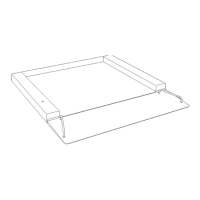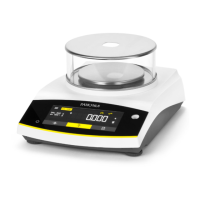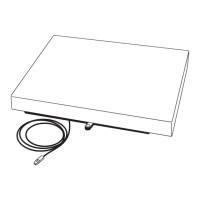Do you have a question about the Sartorius IW2P1x-6ED-L and is the answer not in the manual?
Details safety warning symbols used in the manual.
Covers electrical protection class, grounding, and connection requirements.
Specifies the instrument's measurement category and usage limitations.
Warns of life-threatening danger when opening the instrument.
Advises against exposing the scale to extreme conditions.
Outlines safety procedures for maintenance and repair.
Advises against use in hazardous areas and matches voltage.
Details battery types and scale power status indicators.
Explains how interference can affect readings.
Guidelines for storing and shipping the scale to prevent damage.
Instructions for unpacking and checking the scale for damage.
Lists the components included with the scale.
Steps and considerations for setting up the scale.
Procedure for conditioning the scale after temperature changes.
Identifies the main housing, power cable, and connection glands.
Details the display unit, column, and support foot.
Describes the weighing pan, leveling feet, and indicator.
Locates the optional RS-232 port and manufacturer's ID tag.
Instructions for connecting/disconnecting peripheral devices safely.
Specifies the required warm-up time for accurate results.
Details how to remove the transport lock before use.
Steps for removing the load plate and using foot screws to level.
Ensures all leveling feet are securely on the surface.
Steps for attaching the column bracket and column.
Instructions for installing the display and control unit retainer.
How to open the cover and insert batteries.
Explains battery symbol and low battery warnings.
Overview of weighing cell, display unit, and basic functions.
Details the different parts of the display.
Explains busy symbol, plus/minus signs, and unit status.
Describes how measured values and units are shown.
Details maximum loading capacities based on model and load position.
Settings for On/Off switch, backlight, and auto power off on AC.
Settings for On/Off switch, backlight, and auto power off on battery.
Explains the On/Off key behavior in different modes.
Details keys like Zero, Tare, Gross/Net, Function, Print/Enter.
Steps to switch the scale on/off for configuration.
Explains key functions within the setup menu.
Configurable options for serial communication (Baud rate, Parity, Print option).
Settings for Backlight, Auto Power Off, and Standby Options.
Options for ADC config, units, step width, and calibration.
Step-by-step guide for using the counting function.
Instructions for setting limits and performing check weighing.
Steps to select and toggle between different weight units.
Step-by-step guide for calibrating the scale.
Steps for performing scale linearization.
Explains the structure of data output and ID codes.
Details status-dependent and error-dependent codes.
Explains the structure for entering commands to the scale.
Lists commands for printing, zeroing, taring, and keyboard control.
Commands for adapting to different ambient conditions.
Illustrates the connection diagram for RS-232 interface.
Describes short, block, and continuous printing modes.
Guidance on configuring serial settings and print output.
Defines abbreviations like N, G, T, Chk., OK, HI, LO.
Illustrates sample outputs for short print mode.
Shows sample outputs for block print mode.
Provides examples for continuous printing mode.
Shows sample outputs for unit toggling.
Lists common problems, causes, and solutions for error codes.
Instructions for cleaning the scale and its parts.
Guidelines for safety checks and packaging recycling.
Details keys, display, functions, readability, temp, power.
Compares capacity, readability, repeatability, linearity for models.
Lists optional accessories for the scale.
Details compliance with EMC Directive 2004/108/EC.
Explains compliance with voltage limit Directive 2006/95/EC.
Details safety warning symbols used in the manual.
Covers electrical protection class, grounding, and connection requirements.
Specifies the instrument's measurement category and usage limitations.
Warns of life-threatening danger when opening the instrument.
Advises against exposing the scale to extreme conditions.
Outlines safety procedures for maintenance and repair.
Advises against use in hazardous areas and matches voltage.
Details battery types and scale power status indicators.
Explains how interference can affect readings.
Guidelines for storing and shipping the scale to prevent damage.
Instructions for unpacking and checking the scale for damage.
Lists the components included with the scale.
Steps and considerations for setting up the scale.
Procedure for conditioning the scale after temperature changes.
Identifies the main housing, power cable, and connection glands.
Details the display unit, column, and support foot.
Describes the weighing pan, leveling feet, and indicator.
Locates the optional RS-232 port and manufacturer's ID tag.
Instructions for connecting/disconnecting peripheral devices safely.
Specifies the required warm-up time for accurate results.
Details how to remove the transport lock before use.
Steps for removing the load plate and using foot screws to level.
Ensures all leveling feet are securely on the surface.
Steps for attaching the column bracket and column.
Instructions for installing the display and control unit retainer.
How to open the cover and insert batteries.
Explains battery symbol and low battery warnings.
Overview of weighing cell, display unit, and basic functions.
Details the different parts of the display.
Explains busy symbol, plus/minus signs, and unit status.
Describes how measured values and units are shown.
Details maximum loading capacities based on model and load position.
Settings for On/Off switch, backlight, and auto power off on AC.
Settings for On/Off switch, backlight, and auto power off on battery.
Explains the On/Off key behavior in different modes.
Details keys like Zero, Tare, Gross/Net, Function, Print/Enter.
Steps to switch the scale on/off for configuration.
Explains key functions within the setup menu.
Configurable options for serial communication (Baud rate, Parity, Print option).
Settings for Backlight, Auto Power Off, and Standby Options.
Options for ADC config, units, step width, and calibration.
Step-by-step guide for using the counting function.
Instructions for setting limits and performing check weighing.
Steps to select and toggle between different weight units.
Step-by-step guide for calibrating the scale.
Steps for performing scale linearization.
Explains the structure of data output and ID codes.
Details status-dependent and error-dependent codes.
Explains the structure for entering commands to the scale.
Lists commands for printing, zeroing, taring, and keyboard control.
Commands for adapting to different ambient conditions.
Illustrates the connection diagram for RS-232 interface.
Describes short, block, and continuous printing modes.
Guidance on configuring serial settings and print output.
Defines abbreviations like N, G, T, Chk., OK, HI, LO.
Illustrates sample outputs for short print mode.
Shows sample outputs for block print mode.
Provides examples for continuous printing mode.
Shows sample outputs for unit toggling.
Lists common problems, causes, and solutions for error codes.
Instructions for cleaning the scale and its parts.
Guidelines for safety checks and packaging recycling.
Details keys, display, functions, readability, temp, power.
Compares capacity, readability, repeatability, linearity for models.
Lists optional accessories for the scale.
Details compliance with EMC Directive 2004/108/EC.
Explains compliance with voltage limit Directive 2006/95/EC.











